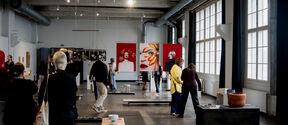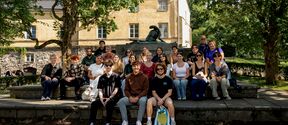Antenna placement for hockey puck transmitter studied at corporate collaboration course
Students presented their solutions at the course’s closing seminar on how to install a data-collecting antenna that can withstand the rigours of the game into a hockey puck’s Bluetooth transmitter.
Radio technology master’s students participating in the Antennas workshop course have had to truly control the puck when designing their antennas. This collaboration with Quuppa, a company that develops intelligent locating technology, is an effort to solve the problem of integrating a data-collecting antenna with hockey pucks that use Quuppa’s locating system. The positioning device is intended to offer more data about the game and therefore enrich the sporting experience.
Solving practical problems motivator for students
Students showed a high level of enthusiasm for the subject, which was also apparent from the closing seminar presentations, as time limits stretched for most presenters. During the course, the work was distributed in a way that allowed each student to choose working methods according to their own interests.
Students designed, manufactured and measured various prototype antennas. Prototypes were tested within the puck, their functioning measured and the results analysed. The study also made use of a computer simulation that made it possible to test how the puck would function in an active game situation and how the antenna would affect the movement of the puck, among other things.
'In my opinion, the assignment was a resounding success, said the teacher for the course, university lecturer Jari Holopainen. It was challenging enough and very interesting. Some of the students liked it so much that getting them to leave the laboratory at the end of the day was a challenge in itself.'
Results through versatile measurement and simulation
The students’ careful measurements showed that the puck’s permittivity, or electric properties, varied and depended on the puck’s manufacturer. Additionally, placing the Bluetooth module in the puck as is would orient its antennas to the sides instead of up and down, which would be a better orientation for data collection.
Measurements and simulations by several groups showed that it's worth coating the antenna in polycarbonate or epoxy. It is possible to coat these so-called low loss materials with puck material in a way that they don’t have an effect on how the puck behaves on ice.
Students’ conclusions also included a proposition that if you want the antenna to radiate up and down, it should be surrounded by a metallic material, for example copper tape.
Holopainen said that the next step is to publish the results at a conference held in Otaniemi next year, the "International Symposium on Electromagnetic Theory 2016".
The results were so promising that students with enough interest will be eligible for additional credits by publishing scientific papers based on the results and presenting them at the conference.
Quuppa was very interested in the students’ work and will make use of them as applicable. It will be possible to use the results to make a functioning prototype hockey puck that uses the interior positioning system.
Also read:
Students work together with business to design a data-collecting ice hockey puck (elec.aalto.fi)
Further information:
Antennas workshop course (mycourses.aalto.fi)
Quuppa (quuppa.com)
Read more news
Growing Materials, Growing Ideas: Inside the BioMaker Studio
At Aalto University’s BioMaker Studio, initiated by Ena Naito, students and researchers experiment with living materials, from algae to mycelium, creating an open, interdisciplinary space where design, biology, and collaboration grow together.
The year in Review: What happened in 2025?
A recap of the milestones of the Master in Contemporary Design in 2025
“This hands-on approach is the absolute best way to learn” – Loyola University and Aalto University partnered for the sixth time
Isabel Towghi shares her experience from Aalto University Summer School.






